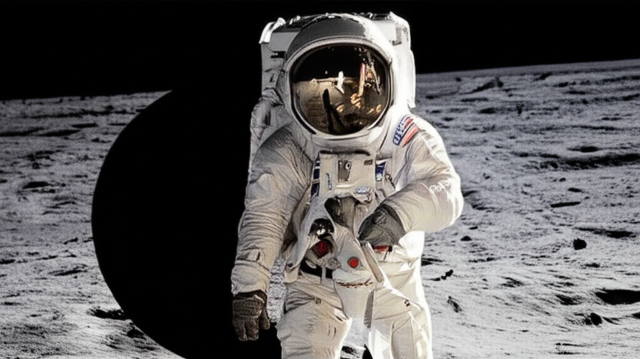
Moon Landing - Fact or Foe?
The Apollo 11 moon landing on July 20, 1969, remains one of history's most significant events. Yet, despite overwhelming evidence, conspiracy theories claiming it was a hoax continue to persist. This post will examine the evidence supporting the moon landing and address some of the most common conspiracy theories.
The Evidence for the Moon Landing
The evidence supporting the Apollo 11 moon landing and the subsequent Apollo missions is extensive and comes from various sources. It's not just about one photograph or video; it's a convergence of independent lines of evidence:
1. Physical Evidence: Moon Rocks
Astronauts brought back over 840 pounds of moon rocks. These rocks have unique compositions significantly different from Earth rocks, confirming their extraterrestrial origin. Scientists worldwide have studied these samples, and their analysis consistently supports their lunar origin. The unique isotopic ratios and mineral compositions are impossible to replicate on Earth.
2. Witness Testimony: Thousands of People Involved
The Apollo program involved hundreds of thousands of people – engineers, scientists, technicians, and support staff. It's statistically improbable that all these individuals would keep a decades-long conspiracy secret. Many have spoken publicly about their roles, and their accounts are consistent with the official narrative.
3. Third-Party Verification: Tracking Stations Around the World
Numerous tracking stations across the globe, including those in friendly and unfriendly nations, tracked the Apollo missions. Independent verification from these stations confirms the trajectories and timing of the missions, leaving no room for a staged event on Earth.
4. Photographic and Video Evidence: Scrutinized and Verified
While some claim anomalies in the photographs and videos are evidence of a hoax, these claims often stem from a lack of understanding of photography in low-gravity environments, lighting conditions on the moon, and the limitations of 1960s technology. Detailed analysis has debunked most of these claims. The presence of features like shadows, light reflections, and the absence of specific artifacts expected in a studio environment all support the authenticity of the images.
5. Retroreflectors on the Moon
Astronauts left retroreflectors on the moon's surface. These mirrors reflect laser beams precisely back to Earth, allowing scientists to precisely measure the distance to the moon. This ongoing experiment provides undeniable proof of the moon landings and continually refines our understanding of lunar distance and Earth's dynamics.
6. Independent Verification from Other Countries
While the US led the Apollo program, other nations, including those with competing space programs, monitored the missions. The lack of any contradictory evidence from these independent observations significantly strengthens the credibility of the moon landings.
Debunking Common Conspiracy Theories
Numerous conspiracy theories allege the moon landing was faked, but these theories usually lack scientific basis and rely on misunderstandings or misinterpretations of evidence:
1. The Waving Flag in a Vacuum
The argument that the flag appears to wave in a vacuum is often cited. However, the flag was rigged with a horizontal bar to make it appear unfurled, creating the illusion of movement. The wrinkles in the fabric, caused by its folded state during transport, remain visible and give the impression of waving.
2. Lack of Stars in the Photographs
The absence of stars in many photos is often pointed to as evidence of a hoax. The lunar surface was brightly lit by the sun, causing extremely short exposure times, making the faint light from distant stars undetectable. The camera settings needed to capture the lunar surface details did not allow for the capture of faint starlight.
3. Identical Backgrounds in Different Photos
Claims of identical backgrounds in different photos are often raised. However, these assertions usually fail to account for the vast, relatively featureless lunar landscape. The repetition of similar terrain elements is expected and doesn't demonstrate fakery. Furthermore, slight variations in lighting and perspective would be minimal across shots, compounding the seeming similarity.
4. The Van Allen Radiation Belts
Concern is sometimes raised about the danger of the Van Allen radiation belts. However, the Apollo missions were carefully timed and planned to minimize exposure. The spacecraft spent only short amounts of time within the high radiation regions, and the shielding provided sufficient protection for the astronauts.
5. Missing Crater Under the Lunar Module
Some argue the lack of a significant crater under the Lunar Module's landing legs contradicts the force of the landing. However, the lunar surface is not like sand; it's composed of fine dust and regolith, which compacts under pressure. The module's legs distributed the weight, leading to relatively minor disturbance of the surface.
Conclusion: The Overwhelming Evidence
The moon landing was not a hoax. The evidence supporting its reality is vast and undeniable. While conspiracy theories can be fascinating, they should not overshadow the overwhelming scientific consensus and historical documentation. The Apollo program was a monumental achievement representing the pinnacle of human ingenuity and collaboration. While some aspects may be open to interpretation or further investigation, the core fact remains: humans walked on the moon.
Understanding the scientific evidence and the historical context is crucial to appreciating the significance of this incredible feat. It's a testament to human potential, pushing the boundaries of scientific and engineering capabilities. Rather than focusing on debunking fanciful claims, it is more fruitful to examine the remarkable details of the Apollo program and the broader implications for space exploration.
No comments:
Post a Comment